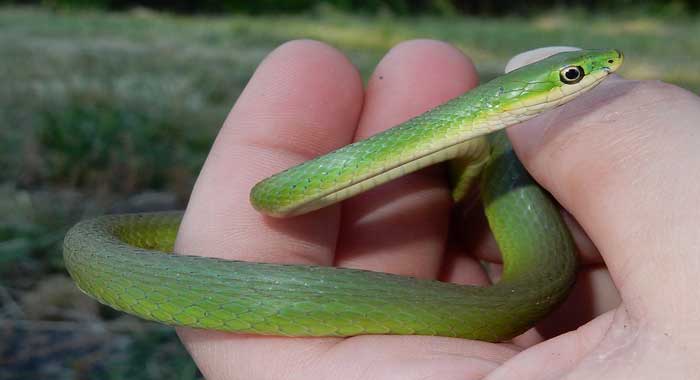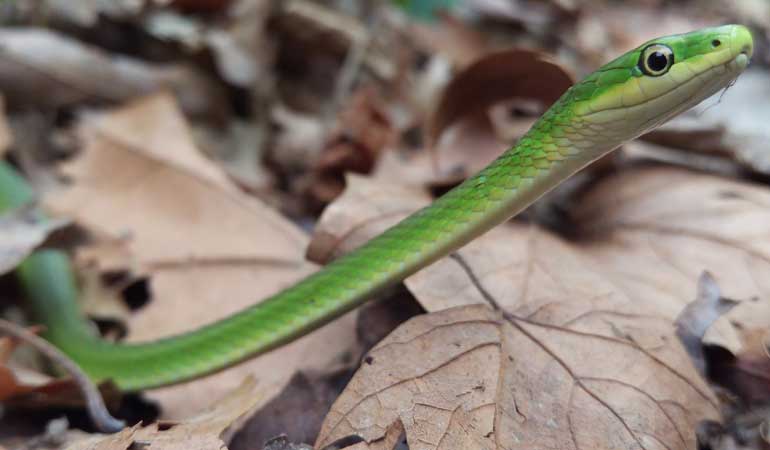Like all snakes, the rough green snake (Opheodrys aestivus) is a timid and pet-friendly reptile. Besides that, they look nicer and are interesting to watch as well. Rough green snakes are diurnal and so they can be active all day. Having an impressive look these snakes are good options for keeping as pets. It could seem like a part of your decoration as it stays in its enclosure.
This snake originated from North America and is sometimes called grass snake or green grass snake but this is referred to as the smooth green snake (Opheodrys vernalis) usually. They are a part of the colubrid family which is the most harmless group of reptiles. The common grass snake and garter snakes are also from this family. Most of them are non-poisonous while the venomous species have fangs in front of their mouth. But these venomous snakes are off-limits for petting at home.
Rough green snakes are beautiful and interesting pets and they can live quite long if you give them the proper treatment. In a healthy environment, rough green snake lifespan is up to 15 years.
This snake loves to play and stays active during the day and is a good prey hunter, mostly insects. Rough green snakes are good eaters and they can be self-sufficient if we can provide the right suitable environment.
This snake is considered to be the Least Concerned according to IUCN, and they are available to adopt as home dwellers. But there is a tendency of catching and selling them in large numbers which could cause a threat to the population in the natural environment.
Rough Green Snake Species Profile
Opheodrys aestivus known as the rough green snake is a green-toned snake as its name implies. It is a harmless snake and non-venomous, so even if it does bite a little it would not be any risk for the human. Let’s have a look at its profile:
Kingdom: Animalia
Phylum: Chordata
Class: Reptilia
Order: Squamata
Suborder: Serpents
Family: Colubridae
Genus: Opheodrys
Species: O. aestivus
Rough Green Snake Care Guide
The Rough Green Snake is generally easy to care for and makes great pets for beginners. Still, you may have a lot to know about its habitat, housing, feeding, and health issues.
This helpful guide covers everything you need to know about the rough green snake as pet, from feeding and housing to health and breeding.
Rough Green Snake Habitat
Rough Green Snakes are found mostly in the Mid-Atlantic and Southeast from the Pine Barrens of New Jersey west to central Texas throughout Florida. They are more present in the coastal plains and lesser in the mountain regions.
The rough green snake is found in a variety of habitats most commonly in forests and edges of the land. They also live near wetlands and rivers to search for insects. These snakes are arboreal in nature and therefore spend a lot of time in trees compared to other species. Sometimes they enjoy swimming in the water. They hunt for insects, spiders, and other invertebrates that live in vegetations above the ground. During the nights these snakes tend to coil up in shrubs or vines or even thick vegetation.
Enclosure Setup for Rough Green Snake
Rough green snake tank setup is comparatively easy. In order to provide a proper enclosure for the rough green snake, it is important to know its habits and lifestyle. Rough green snakes are active and they need some space to move around freely. Also, they enjoy swimming at least once daily so it is better to keep a water area inside their enclosure. An aquarium is a common option for the rough green snake if kept as a pet at home. Here is one example of a proper enclosure.
It is also required to keep the humidity of the enclosure at 55 -65 % and this can be achieved by using mist or automatic foggers with the setup. More or lesser than this amount could cause difficulties for the snake.
Also, the enclosure should receive enough sunlight and be moderately warm. We can add some hideaways for the snake to travel with less exposure.
30 gallon is the ideal Rough green snake tank size. A 50 to 75-gallon tank is best suited if you keep two rough green snakes.
Feeding and survival
Rough green snakes need plenty of water and proper food if you want to keep them healthy active. The water needs to be refreshed daily just like any other pet animal and given in a good-sized water bowl. Also, when given water it should be in a safe fixed place where it will not tip over or wet the enclosure inside. This can increase the humidity.
Rough Green Snakes like insects very much and they need to be fed two to three times a day. There are a variety of soft-bodied insects such as crickets, moths, caterpillars, crane flies, and wax worms. You can let some small fish into the water bowl to let the snake swim and fish at the same time.
Rough Green Snake Handling Tips

Rough green snakes like to hide away from exposure and are quite delicate. These snakes usually are not the kind of pets that you need to hold frequently like cats or dogs. They prefer to keep secluded more often than many other pet snakes. If you have to hold it once in a while then you need to ensure that you hold it quite lightly to make sure it is not bruised.
The best way is to let the snake move to your hand by itself instead of pulling it by your hand. It will tend to coil around your fingers. Also, it has to be held close to your body to make it feel safe and covered. It is better to hold the snake for a short period of time and not throughout the day. It is often recommended to not hold your snake 24 hours before or after its feeding. This might cause regurgitation of its food.
Another good thing is this snake does not bite so if it feels threatened it will simply react or try to hide away.
Health and Diseases of Rough Green Snake
There are many kinds of diseases that a rough green snake could catch or suffer. Here are some of these:
External parasites: The most common external parasite is the mite. These can multiply in numbers and attack the snake’s skin or scales. They look like black or red dots and burrow under the scales to bite the skin. Due to poor hygiene in the enclosure, this becomes a nuisance for the pet owner.
Internal parasites: Internal parasites are common mostly when the snake is brought from the wild into your home. They can carry a huge number of parasites. Other than that, the snakes are infected internally by contact with unclean environments in their enclosure or from eating unhygienic food. Some common parasites are roundworms, hookworms, and pinworms.
In these cases, the snake will undergo symptoms like poor appetite, weight loss, vomiting, abnormal stools, or even diarrhea.
Mouth Rot: Mouth Rot or scale are another common diseases for these snakes which are caused by a bacterial infection in the skin. Often a liquid substance known as pus can be seen in the mouth area or skin. It also shows a different coloration most likely red.
Respiratory Infections: Respiratory problems may arise in the snake due to improper temperature control or humidity in its enclosure. When the humidity is too high the snake tends to start breathing through its mouth and there will be mucus coming out of its nostrils. It will also make noises like bubbling or gurgling which will tell that it is having difficulty breathing.
Fungal Infection: Fungal infection is a serious problem for snakes. It can lead to blindness and has to be treated immediately. The infection will attack its eyes and scales. Therefore, we need to keep a clean environment for this not to happen.
Treatment: A good way of treating parasites internally is by using dewormers or anthelmintics. Besides that, there are specific medications for parasites such as antibiotics. Then again, all medicines don’t treat all parasites. In that case, it is better to consult a doctor.
For internal parasites, there are oral or injections for antibiotics. In case of emergencies like Septicemia, it is wise to immediately treat your pet snake at the hospital.
Important Guidelines to Follow
The Rough Grass Snake is a small and delicate reptile and it has many traits that are common to the snake family. But every species of this family carries some distinction from each other. Just like their variation in name and scientific backgrounds they also vary in nature and lifestyles. Here are some important guidelines to follow when planning to keep a pet like the rough green snake at home:
- Proper food and water availability
- Immediate attention to diseases or anomalies in behavior
- Provide space and time for them to be alone
- Daily hygiene and cleaning of enclosure and food intake sources
- Maintenance of temperature and humidity
- A good and well-equipped enclosure
- A well-protected enclosure
If your pet snake gets the good care and assistance it needs, you can ensure a long life for it. As long as you are prepared and know everything that is needed to nurture and keep your pet snake happy it is not long enough to make it adjust to your home. As mentioned before rough green snakes are timid and easy to make friends with your environment.

